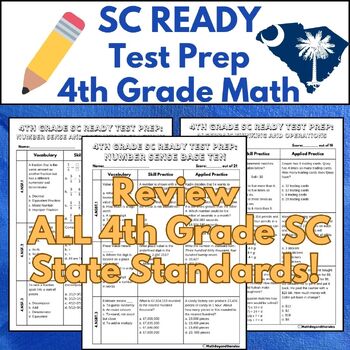South Carolina SC READY Test Practice and SC READY Review 4th Grade Math
Math Beyond the Rules
17 Followers
Grade Levels
4th
Subjects
Resource Type
Standards
CCSS4.MD.A.1
CCSS4.MD.A.2
CCSS4.MD.A.3
CCSS4.MD.B.4
CCSS4.MD.C.5
Formats Included
- PDF
Pages
12 pages
Math Beyond the Rules
17 Followers
Description
Want to get your students ready for SC READY? This end of the year SC READY Test Prep Review assesses all SC State Standards for 4th grade math.
What is Included?
-Sections are broken by strand.
- Number Sense Base 10 - 21 Questions
- Number Sense Fractions - 24 Questions
- Algebraic Thinking - 18 Questions
- Geometry - 12 Questions
- Measurement and Data - 24 Questions
- Keys for every section
How to Use with Your Students?
- Assess students independently and see what successes and areas of support your students need before testing.
- Or use in Whole Group or Small Group to Riview.
Questioning Types
Each standard has 3 questions
- Vocabulary Based: Identify if your students understand the math academic vocabulary that is used throughout the SC Ready Test.
- Skill Practice: Identify if your students understand basic level 1 questioning.
- Applied Practice: Identify if your students can apply the skill in word problems that assess level 2 and 3 questioning.
How to Give?
- Give the whole review to prep for testing like environment and create an opportunity to enhance student test taking stamina.
or
- Give strand sections separately so that you can monitor and adjust student supports in weaker areas.
Why is This Review Beneficial?
This review identifies-
- Do students understand the vocabulary that will be on SC READY?
- Are students only able to answer skill practice questions/Level 1 questioning or are they able to apply it to a real-world problem/ Level 2 or 3 questioning.
- Are your students struggling with one strand in particular?
- Are your students struggling with one standard in particular?
BE SURE TO LEAVE A REVIEW IN EXCHANGE FOR TPT CREDITS TOWARDS YOUR ACCOUNT FOR YOUR NEXT PURCHASE! :)
Total Pages
12 pages
Answer Key
Included
Teaching Duration
N/A
Last updated 2 months ago
Report this resource to TPT
Reported resources will be reviewed by our team. Report this resource to let us know if this resource violates TPT’s content guidelines.
Standards
to see state-specific standards (only available in the US).
CCSS4.MD.A.1
Know relative sizes of measurement units within one system of units including km, m, cm; kg, g; lb, oz.; l, ml; hr, min, sec. Within a single system of measurement, express measurements in a larger unit in terms of a smaller unit. Record measurement equivalents in a two-column table. For example, know that 1 ft is 12 times as long as 1 in. Express the length of a 4 ft snake as 48 in. Generate a conversion table for feet and inches listing the number pairs (1, 12), (2, 24), (3, 36),...
CCSS4.MD.A.2
Use the four operations to solve word problems involving distances, intervals of time, liquid volumes, masses of objects, and money, including problems involving simple fractions or decimals, and problems that require expressing measurements given in a larger unit in terms of a smaller unit. Represent measurement quantities using diagrams such as number line diagrams that feature a measurement scale.
CCSS4.MD.A.3
Apply the area and perimeter formulas for rectangles in real world and mathematical problems. For example, find the width of a rectangular room given the area of the flooring and the length, by viewing the area formula as a multiplication equation with an unknown factor.
CCSS4.MD.B.4
Make a line plot to display a data set of measurements in fractions of a unit (1/2, 1/4, 1/8). Solve problems involving addition and subtraction of fractions by using information presented in line plots. For example, from a line plot find and interpret the difference in length between the longest and shortest specimens in an insect collection.
CCSS4.MD.C.5
Recognize angles as geometric shapes that are formed wherever two rays share a common endpoint, and understand concepts of angle measurement:





